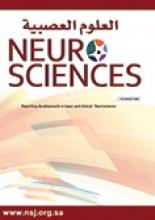Systematic ReviewSystematic Review
Open Access
Positron emission tomography and perfusion weighted imaging in the detection of brain tumors recurrence
A meta-analysis
Tareef S. Daqqaq and Ayman S. Alhasan
Neurosciences Journal July 2022, 27 (3) 131-142; DOI: https://doi.org/10.17712/nsj.2022.3.20210146
Tareef S. Daqqaq
From the Department of Radiology, College of Medicine, Taibah University, Al Madinah Al Munawwarah, Kingdom of Saudi Arabia.
MBBS, FacharztAyman S. Alhasan
From the Department of Radiology, College of Medicine, Taibah University, Al Madinah Al Munawwarah, Kingdom of Saudi Arabia.
MBBS, DES
References
- 1.↵
- Kheirollahi M,
- Dashti S,
- Khalaj Z,
- Nazemroaia F,
- Mahzouni P.
- 2.↵
- Perkins A,
- Liu G.
- 3.↵
- Lin X,
- DeAngelis LM.
- 4.↵
- Langleben DD,
- Segall GM.
- 5.↵
- Louis DN,
- Ohgaki H,
- Wiestler OD,
- Cavenee WK,
- Burger PC,
- Jouvet A, et al.
- 6.↵
- Gállego Pérez-Larraya J,
- Delattre J.
- 7.↵
- 8.↵
- 9.↵
- De Vleeschouwer S
- Tamimi AF,
- Juweid M.
- 10.↵
- Ostrom QT,
- Cote DJ,
- Ascha M,
- Kruchko C,
- Barnholtz-Sloan JS.
- 11.↵
- Minniti G,
- Filippi AR,
- Osti MF,
- Ricardi U.
- 12.↵
- Winter SF,
- Loebel F,
- Loeffler J,
- Batchelor TT,
- Martinez-Lage M,
- Vajkoczy P, et al.
- 13.↵
- 14.↵
- Wang L,
- Wei L,
- Wang J,
- Li N,
- Gao Y,
- Ma H, et al.
- 15.↵
- Wen PY,
- Macdonald DR,
- Reardon DA,
- Cloughesy TF,
- Sorensen AG,
- Galanis E, et al.
- 16.↵
- 17.↵
- 18.↵
- Testud B,
- Brun G,
- Varoquaux A,
- Hak JF,
- Appay R,
- Le Troter A, et al.
- 19.↵
- Langen KJ,
- Heinzel A,
- Lohmann P,
- Mottaghy FM,
- Galldiks N.
- 20.↵
- Treglia G,
- Muoio B,
- Trevisi G,
- Mattoli MV,
- Albano D,
- Bertagna F, et al.
- 21.↵
- Långström B,
- Antoni G,
- Gullberg P,
- Halldin C,
- Malmborg P,
- Någren K, et al.
- 22.↵
- 23.↵
- 24.↵
- Liberati A,
- Altman DG,
- Tetzlaff J,
- Mulrow C,
- Gøtzsche PC,
- Ioannidis JPA, et al.
- 25.↵
- Stroup DF,
- Berlin JA,
- Morton SC,
- Olkin I,
- Williamson GD,
- Rennie D, et al.
- 26.↵
- Whiting PF,
- Rutjes AW,
- Westwood ME,
- Mallett S,
- Deeks JJ,
- Reitsma JB, et al.
- 27.↵
- 28.↵
- 29.
- 30.
- 31.
- Estrada G,
- González-Maya L,
- Celis-López MA,
- Gavito J,
- Lárraga-Gutiérrez JM,
- Salgado P, et al.
- 32.
- Hatzoglou V,
- Yang TJ,
- Omuro A,
- Gavrilovic I,
- Ulaner G,
- Rubel J, et al.
- 33.
- 34.
- Jabeen S,
- Arbind A,
- Kumar D,
- Singh PK,
- Saini J,
- Sadashiva N, et al.
- 35.
- 36.
- Prat R,
- Galeano I,
- Lucas A,
- Martínez JC,
- Martín M,
- Amador R, et al.
- 37.
- 38.
- Qiao Z,
- Zhao X,
- Wang K,
- Zhang Y,
- Fan D,
- Yu T, et al.
- 39.↵
- Sacconi B,
- Raad RA,
- Lee J,
- Fine H,
- Kondziolka D,
- Golfinos JG, et al.
- 40.↵
- 41.↵
- 42.↵
- Lee J,
- Wang N,
- Turk S,
- Mohammed S,
- Lobo R,
- Kim J, et al.
- 43.↵
- Yu FF,
- Rapalino O. Treated Gliomas
- 44.↵
- 45.↵
- Taghipour Zahir S
- 46.↵
- Aquino D,
- Gioppo A,
- Finocchiaro G,
- Bruzzone MG,
- Cuccarini V.
- 47.↵
- 48.↵
- 49.↵
- Nihashi T,
- Dahabreh IJ,
- Terasawa T.
- 50.↵
- 51.↵
- Spence AM,
- Muzi M,
- Link JM,
- O’Sullivan F,
- Eary JF,
- Hoffman JM, et al.
- 52.↵
- de Zwart PL,
- van Dijken BRJ,
- Holtman GA,
- Stormezand GN,
- Dierckx RAJO,
- Jan van Laar P, et al.
- 53.↵
- Vagal A,
- Vossough A,
- Lev MH,
- Wintermark M.
- 54.↵
- Essig M,
- Shiroishi MS,
- Nguyen TB,
- Saake M,
- Provenzale JM,
- Enterline D, et al.
- 55.↵
- Li Z,
- Zhou P,
- Xiong Z,
- Ma Z,
- Wang S,
- Bian H, et al.
- 56.↵
- Berger M,
- Gould MK,
- Barnett PG.
- 57.↵
- Imrey PB.
In this issue
Positron emission tomography and perfusion weighted imaging in the detection of brain tumors recurrence
Tareef S. Daqqaq, Ayman S. Alhasan
Neurosciences Journal Jul 2022, 27 (3) 131-142; DOI: 10.17712/nsj.2022.3.20210146
Jump to section
Related Articles
- No related articles found.
Cited By...
- No citing articles found.





